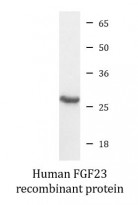ARG70129
Human FGF23 recombinant protein (Active) (His-tagged, C-ter)
Human FGF23 recombinant protein (Active) (His-tagged, C-ter) for SDS-PAGE
Overview
| Product Description | E. coli expressed, His-tagged (C-ter) Active Human FGF23 recombinant protein |
|---|---|
| Tested Application | SDS-PAGE |
| Target Name | FGF23 |
| Species | Human |
| A.A. Sequence | Tyr25 - Ile251 |
| Expression System | E. coli |
| Activity | Active |
| Activity Note | Determined by its ability to induce proliferation in BaF3 cells transfected with human FGFRIIIc. The ED50 for this effect is < 0.3 μg/mL. |
| Alternate Names | ADHR; Phosphatonin; HPDR2; FGFN; Tumor-derived hypophosphatemia-inducing factor; PHPTC; FGF-23; Fibroblast growth factor 23; HYPF |
Properties
| Form | Powder |
|---|---|
| Purification Note | Endotoxin level is less than 0.1 EU/µg of the protein, as determined by the LAL test. |
| Purity | > 98% (by SDS-PAGE) |
| Buffer | PBS (pH 8.0) |
| Reconstitution | It is recommended to reconstitute the lyophilized protein in sterile water to a concentration not less than 200 μg/mL and incubate the stock solution for at least 20 min at room temperature to make sure the protein is dissolved completely. |
| Storage Instruction | For long term, lyophilized protein should be stored at -20°C or -80°C. After reconstitution, aliquot and store at -20°C or -80°C for up to one month. Storage in frost free freezers is not recommended. Avoid repeated freeze/thaw cycles. Suggest spin the vial prior to opening. |
| Note | For laboratory research only, not for drug, diagnostic or other use. |
Bioinformation
| Gene Symbol | FGF23 |
|---|---|
| Gene Full Name | fibroblast growth factor 23 |
| Background | This gene encodes a member of the fibroblast growth factor family of proteins, which possess broad mitogenic and cell survival activities and are involved in a variety of biological processes. The product of this gene regulates phosphate homeostasis and transport in the kidney. The full-length, functional protein may be deactivated via cleavage into N-terminal and C-terminal chains. Mutation of this cleavage site causes autosomal dominant hypophosphatemic rickets (ADHR). Mutations in this gene are also associated with hyperphosphatemic familial tumoral calcinosis (HFTC). [provided by RefSeq, Feb 2013] |
| Function | Regulator of phosphate homeostasis. Inhibits renal tubular phosphate transport by reducing SLC34A1 levels. Upregulates EGR1 expression in the presence of KL (By similarity). Acts directly on the parathyroid to decrease PTH secretion (By similarity). Regulator of vitamin-D metabolism. Negatively regulates osteoblast differentiation and matrix mineralization. [UniProt] |
| Cellular Localization | Secreted. Note=Secretion is dependent on O-glycosylation. [UniProt] |
| PTM | Following secretion this protein is inactivated by cleavage into a N-terminal fragment and a C-terminal fragment. The processing is effected by proprotein convertases. O-glycosylated by GALT3. Glycosylation is necessary for secretion; it blocks processing by proprotein convertases when the O-glycan is alpha 2,6-sialylated. Competition between proprotein convertase cleavage and block of cleavage by O-glycosylation determines the level of secreted active FGF23. [UniProt] |
Images (1) Click the Picture to Zoom In






